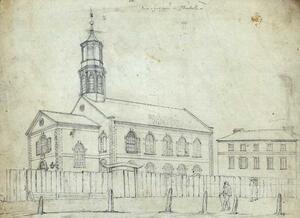The first American Jewish community began in September 1654, when the ship the Sainte Catherine docked in New Amsterdam. Among the passengers were 23 Jews—a group of men, women, and children—who had started their journey in Brazil. Along the way, the ship was attacked by pirates, and all of the worldly goods that the emigrants had brought with them were taken. Nonetheless, the travelers were hopeful as they reached the shores of what we now call New York.
These first arrivals were Sephardic Jews, Jews whose families were originally from Spain and had fled from the Inquisition, which forced all non-Catholics to convert or leave by August 1492. Some Sephardic Jews fled to countries across Europe and the Mediterranean, while others settled in Portugal until 1580, when Portugal and Spain were united under one rulership, and again the Jews were forced to leave.
Holland, in northern Europe, was a haven of tolerance for the Jews, as well as a booming center of business. In 1630, Holland took over the Portuguese colony of Brazil, and many Dutch citizens moved to the new colony or traveled back and forth to do business there. The Dutch Sephardi Jews were at a real advantage in this trade because they knew both the Dutch and Portuguese languages. A thriving Jewish life existed in Brazil, with synagogues, a rabbi, a Jewish school, and approximately 5000 Jews at the community’s height. But in 1653, Portugal regained control of Brazil, and the province’s remaining Jews took flight once again.
Some of the Brazilian Jews returned to Amsterdam and others found homes across the West Indies, but 23 found their way to a small Dutch outpost in North America, trusting that New Amsterdam would match the tolerance of its namesake. When they arrived, however, the Governor of New Amsterdam, Peter Stuyvesant, believed the Jews would “infect and trouble this new colony,” and he ordered them to leave on the next boat. The Jewish community protested, confident in their status as upright Dutch citizens. Prominent Jews in Amsterdam wrote a letter on their behalf to the Dutch West India Company, stating their case. Months later, the answer came in the form of a letter to Governor Stuyvesant, saying that barring the Jews from New Amsterdam would be “unreasonable and unfair.” The letter did require, however, that in order for the Jews to stay, they would have to look after their own people and not depend on any charity from Christians.
Life was not easy for these first Jewish settlers. Governor Stuyvesant was still unhappy about the presence of Jews in the colony. He forbid them to trade along the upper Hudson River and refused to let them enter the militia (a task all other free men engaged in). But both Jewish assertiveness and practical realities overtook Stuyvesant’s discriminatory principles; Jewish men fought for the right to greater trade, the Dutch West India Company overruled Stuyvesant’s restrictions, and as necessity required more able-bodied men to fight the Native Americans, Jews were soon allowed to take on that role as well.
Jews continued to arrive in the newly British colony throughout the 1600s and 1700s. These were both Sephardim and, increasingly, also Ashkenazim (Jews of Central and Eastern European descent). In some regions of America, they met certain restrictions because of their religion, especially in the devout Puritan areas, such as Massachusetts, where Jews were not allowed to settle or build synagogues until the 1800s. In other regions, Jews were welcomed, built synagogues, and had thriving communities. Records date the first congregation to 1693 at the latest, in New York; in 1730, this congregation built the earliest North American synagogue. The oldest synagogue that still exists is the Touro Synagogue, in Newport, Rhode Island, built in 1763.
Overall, Jews enjoyed much more freedom in the new country than they had in Europe. Jews in America could own land, engage in any type of business, employ Christians, and mix socially with Jews or non-Jews, and they had access to the same legal system as Christians. Though they were sometimes received coldly, Jews in early America were ultimately accepted, in large part because of their commercial roles. Jewish business networks spanned from Europe to ports throughout the New World, and the first significant Jewish communities in America were built in the port cities of New York, Philadelphia, Newport, Charleston, and Savannah.



